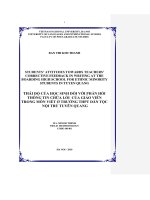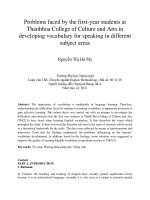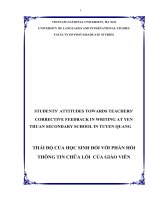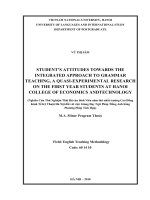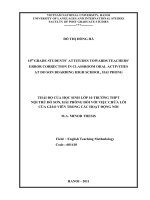The students’ attitudes towards teachers’ written feedback strategies on their writings at Vocational College of Posts and Telecommunications
Bạn đang xem bản rút gọn của tài liệu. Xem và tải ngay bản đầy đủ của tài liệu tại đây (318.33 KB, 16 trang )
VIETNAM NATIONAL UNIVERSITY, HA NOI
UNIVERSITY OF LANGUAGES AND INTERNATIONAL STUDIES
FACULTY OF POST-GRADUATE STUDIES
LÊ HẢI ĐOÀN
THE STUDENTS’ATTITUDES TOWARDS TEACHERS’WRITTEN
FEEDBACK STRATEGIES ON THEIR WRITINGS AT VOCATIONAL
COLLEGE OF POSTS AND TELECOMMUNICATIONS
(Thái độ của sinh viên đối với cách thức phản hồi dưới dạng viết của giáo viên
trên bài viết của sinh viên trường Cao đẳng nghề Bưu Chính Viễn Thông)
M.A. MINOR PROGRAMME THESIS
Field: English Teaching Methodology
Code: 60140111
HANOI – 2016
VIETNAM NATIONAL UNIVERSITY, HA NOI
UNIVERSITY OF LANGUAGES AND INTERNATIONAL STUDIES
FACULTY OF POST-GRADUATE STUDIES
LÊ HẢI ĐOÀN
THE STUDENTS’ATTITUDES TOWARDS TEACHERS’WRITTEN
FEEDBACK STRATEGIES ON THEIR WRITINGS AT VOCATIONAL
COLLEGE OF POSTS AND TELECOMMUNICATIONS
(Thái độ của sinh viên đối với cách thức phản hồi dưới dạng viết của giáo viên
trên bài viết của sinh viên trường Cao đẳng nghề Bưu Chính Viễn Thông)
M.A. MINOR PROGRAMME THESIS
Field: English Teaching Methodology
Code: 60140111
Supervisor: Assoc. Prof. Dr. Lê Hùng Tiến
HANOI - 2016
DECLARATION
I, Lê Hải Đoàn, hereby declare that this thesis is my own work, and I have
provided fully documented references to the work of others. In addition, this thesis
has not been submitted for assessment in other formal courses in any other
university. I also accept all the requirements of ULIS relating to the retention and
use of M.A Graduation Thesis deposited in the library.
Hanoi, 2016
Lê Hải Đoàn
1
ACKNOWLEDGEMENTS
First of all, I would like to express my sincere thanks to Associate Professor,
Doctor Le Hung Tien, for the support, guidance and valuable critical feedback. His
help, stimulating suggestion and encouragement helped me a lot right from the
beginning to the end of this study.
I would like acknowledge my thanks to the students at Vocational College of
Posts and Telecommunications in Hanoi who helped me a lot and showed great
willingness to take part in my survey.
My special thanks also go to my lecturers, my friends, my classmates for
valuable comments and criticism, their interest and encouragement.
Last but not least, I want to express my deepest gratitude to my parents and
friends for their love, care, tolerance and encouragement.
2
ABSTRACT
This study investigates the students’ attitudes towards teachers’ written
feedback at Vocational College of Posts and Telecommunications in Hanoi. The
participants included 80 non-English major freshmen. The data were collected from
survey questionnaire and the interview with 12 students at different level of English
proficiency. The results show that the students highly valued the importance of
teacher’s feedback and had different attitudes towards each type of them; especially
they prefer direct feedback to the others. It is suggested that the use of direct should
be maintained regularly, so as to not only satisfy student’s interests on writing, but
also improve students’ writing fluency by practicing writing. In terms of the
students’ comprehension of teacher written feedback, the results show that most of
them had difficulty in understanding uncoded and content feedback. Based on their
responses about the ways they deal with the feedback, they are divided into two
groups: independent students who themselves tried to understand teacher written
feedback through books or internet and dependent students who asked their teacher
or friends for help. Thus, it is expected that the research results can provide EFL
writing teachers with pedagogical implications to improve EFL students’ writing
performance.
3
PART 1: INTRODUCTION
1. Rationale of the study
“What is the shortest word in the English language that contains the letters: abcdef?
Answer: Feedback. Don't forget that feedback is one of the essential elements of
good communication.” (Anonymous)
English writing, going with global development, has become an important
instrument for students to get better jobs. Advice, evaluation, grades - none of these
may give the descriptive information that students need to reach their goals in
writing. Moreover, marking student’ writing is always considered one of the most
difficult tasks for an English teacher. After receiving students’ written work, teacher
starts correcting errors, rearranging word order, leaving comments and eventually
giving the mark. Some researchers in writing (Leki, 1991; Raimes, 1983) have
belief in that giving feedback is one of the important methods for teachers to help
the student writers improve their writing pieces. Up to now, feedback used in
educational context is considered as an essential part of the teaching and learning
process to improve knowledge and skill acquisition. Although many studies have
been written on the subject of error correction in writing and the question about its’
effectiveness is open-ended, we have to admit that students want feedback and
teachers feel obliged to provide it. Moreover, many studies give more attention to
the importance of feedback, the ways of providing and receiving feedback and how
feedback has effect on students’ writing. We can see in the study of Lee (2005),
Noora (2006).“What have been neglected in those studies are preferences and
attitudes of the learners and teachers towards error correction” (Katayama,2007).
He also stated:“ Differences in learners” learning styles affected the learning
environment by either supporting or inhibiting their intentional cognition and active
engagement”. In addition, “matching the learning styles of the students and the
teaching style of the teacher would help improve students’ learning, attitudes,
behavior, and motivation” (Ferris, 2003).
4
Also, a large number of studies on feedback types have been carried out; however, a
few ones pay attention to the ways the students deal with the errors after receiving
feedback from their teachers. It can be seen in some previous studies investigated
the effects of different types of feedback on grammatical improvement in students’
writing (Fathman & Walley,1990; Padgate,1999; Hyland,2003) or surveyed
students’ preferences for error correction (Cohen, 1987; Leki, 1991; Ferris, 2006).
Therefore, it is crucial to find out the feedback through which students prefer
receiving, their attitudes towards, their comprehension of and their attention to
different types of teacher written feedback. It is hoped that the results of this study
would help teachers to be more effective in teaching English.
2. Aims of the study
The aim of the present study is to examine the students’ attitudes towards teachers’
written feedback strategies. Moreover, the study aims to find out whether the
students understand the written feedback as intended by their teacher. Finally, the
study aims to find out the students’ strategies for handling feedback after they
received their writings.
3. Research questions
To achieve the purposes of the study, the following questions were developed:
1. What are the students’ attitudes towards teacher’ written feedback strategies?
2. To what extent do the students understand teacher written feedback?
3. How do the students handle the feedback they receive?
4. Significance of the study
Feedback is an essential component of any English language writing course that
second language students expect to receive. It is necessary in the students’ whole
writing process. There exists a conflict between teacher written feedback on
compositions and the learner’s interest. This mismatch between the needs of the
students and those of the teachers can affect the practical effectiveness of the
written feedback.
5
REFERENCES
Ashwell, T. (2000). Patterns of teacher response to student writing in a multipledraft composition classroom: Is content feedback followed by form feedback
the best method? Journal of Second Language Writing, 9, 227 – 257.
Baker,C. (1992). Attitudes and Language. Elevedon : Multilingual Matter.
Batstone, R. (1994). Grammar. Oxford University Press
Beuningen,C. (2011). The effectiveness of comprehensive corrective feedback on
second language writing. (Doctoral dissertation).Retrieved from Universiteit
van Amsterdam Digital Academic Repository.
Bitchener, J., Young, S., & Cameron, D. (2004). The effects of different types of
corrective feedback on ESL student writing. Journal of Second Language
Writing, 14, 191 – 205.
Bitchener,J. and U.Knoch . (2008). The value of written corrective feedback for
migrant
and international students’.Language Teaching Research Journal
12/3: 409-31
Casanave, C.P (2004). Controversies in Second Language Writing: Dilemmas and
Decisions in Research and Instruction.Ann Arbor: University of Michigan
Press.
Connor, U. M., & Asenavage, K. (1994). Peer response groups in ESL writing
classes: How much impact on revision? Journal of Second Language Writing,
3, 257-276.
Chandler, J. (2003). The efficacy of various kinds of error feedback for improvement
in the accuracy and fluency of L2 student writing. Journal of Second Language
Writing, 12, 267 – 296.
Chaney, S. J. (1999). The effect of error types on error correction and revision.
Master’s thesis, California State University, Sacramento.
6
Charles, M. (1990). Responding to problems in written English using a student selfmonitoring technique. ELT Journal, 44, 286 – 293.
Child, D. (1973) Psychology and the Teacher. Second Edition. 1977. H. Rinehart
and Winston. LTD, pp,236-62
Chittima Kaweera & Dr. Siriluck Usaha (2008). The Impact of Different Types of
Teacher Written Feedback on EFL University Students’ Writing. KKU Res J
(GS) 8
Cohen,A.D, & Cavalcanti M C. (1990). Feedback on composions: Teacher and
student verbal reports. In B Kroll (Ed.),Second Language Writing: Research
Insights for the Classroom.Cambridge : Cambridge University Press.
Connor,U & Asenavage,K.(1994). Peer response groups in ESL writing classes:
How much impact on revision? Journal of Second Language Writing, 3, 257276
Cumming, A. (2001). Learning to write in a second language: Two decades of
research. International Journal of English Studies, 1(2), 1-23
Daniel Kasule, Violet B. Lunga (2010). Attitudes of second language students
towards self-editing their own written texts. Reading & Writing ;Vol 1,No 1
Ellis, R. (1997). Second language acquisition. Oxford: Oxford University Press.
Fathman, A. & Walley, E. (1990). Teacher response to student writing: Focus on
Form versus content. In B. Kroll (Ed.), Second language writing: Research
insights for the classroom (pp. 178 – 190). New York: Cambridge University
Press.
Fasold,R. (1984). The sociolinguistics of society. Oxford : Blackwell
Fazio, L. L. (2001). The effect of corrections and commentaries on the journal
writing accuracy of minority- and majority-language students. Journal of
Second Language Writing, 10, 235 – 249.
7
Ferris, D. (1995). Student’s reaction to teacher response in multiple-draft
composition classrooms. TESOL Quarterly, 29, 33-53
Ferris, D. R (1999). The case for grammar correction in L2 writing classes: A
response to Truscott(1996).‟ Journal of Second Language Writing,8:1-11
Ferris, D. (2002). Treatment of error in second language student writing. Michigan:
The University of Michigan Press.
Ferris, D. & Roberts, B. (2001). Error feedback in L2 writing class: How explicit
does it need to be? Journal of Second Language Writing, 10, 161– 84.
Ferris, D. (2003). Responding to writing. In Kroll, B. (Ed.) Exploring the dynamics
of second language writing (119 – 140). Cambridge: Cambridge University
Press.
Ferris, D. (2006). Does error feedback help student writers? New evidence on the
short- and long-term effects of written error correction. In K. Hyland & F.
Hyland (Eds.), Feedback in second language writing: Contexts and issues
(pp.81-104). New York: Cambridge University Press.
Ferris, D. R., Pezone, S., Tade, C.R., & Tinti, S. (1997). Teacher commentary on
student writing: Descriptions and implications. Journal of Second Language
Writing, 2, 155 – 182.
Ferris, D.R. & Hedgcock, J. S. (1998). Teaching ESL composition: Purpose,
process and practice. Mahwah, NJ: Lawrence Erlbaum Associates.
Gass, S. (1983). The development of L2 intuitions. TESOL Quarterly, 17, 273 – 291.
Grami Mohammad A.Grami. (2005).The effect of teachers’ written feedback on ESL
Students’ prerception : A study in a Saudi University- Level context. Annual’
Review of Education, Communication and Language Sciences, Volume
2,2005.
Gee,T. C. (1972). Students’ responses to teacher comments. Research in the
Teaching of English, 6,212-221
8
Harris, Muriel and Tony Silva.(1993).Tutoring ESL Students: Issues and Options.
CCC 44,4,525-537.
Hattie,J, & Timperley,H.(2007).The power of feedback. Review of Educational
Research,77(1),81-112
Hedge,T. (2000). Teaching and learning in the language classroom. Oxford
University Press.
Hendrickson, J. M. (1980). The treatment of error in written work. Modern
Language Journal, 64, 216 – 221.
Huberman & Miles M.(1994).An expanded source book: Qualitative data analysis.
London : sage
Hyland, K. (2002). Teaching and researching writing. New York: Longman
Hyland, K. (2003). Second language writing. Cambridge: Cambridge University
Press.
Hyland, K. & Hyland, F. (2006). Feedback in second language writing. New York:
Cambridge University Press.
Ibrahim, N, (2002).Feedback on ESL : Can we integrate form? Unpublished PhD
Dissertation. The University of Arizona.
Katayama,A.(2007). Japhanese EFL Students’ Preferences toward Corection ò
Classroom Oral Erors. Volume 9. Isue 4 Articla 19. />Keh, C.L.(1990). Feedback in the Writing Process : a Model and Methods for
Implementation. ELT Journal, 4:294 – 304.
Kim,J. H. (2004).Issues of corrective feedback in second language acquisition.
Working papers in TESOL & Applied Linguistics, 2(4), 1-24.
9
Kluger,A. B., & DeNisi, A. (1996).The effects of feedback interventions on
performance :a historical review, a meta-analysis, and a preliminary feedback
intervention theory. Psychological Bulletin, 119(2), 254-284.
Kepner, C. G. (1991). An experiment in the relationship of types of written feedback
to the development of second language writing skills. The Modern Language
Journal, 73, 305 – 313.
Kvale,D. (1996). Interviews. London : SAGE Publications
Lalande, J. (1982). Reducing Composition Errors: An Experiment. Modern
language Journal, 66, 140 – 149.
Lee, I. (1997). ESL learners' performance in error correction in writing: some
implications for teaching. System, 25, 465 – 77.
Lee, I. (2003). L2 writing teachers’ perspectives, practices and problems regarding
error feedback. Assessing Writing, 8, 216 – 237.
Lee, I. (2004). Error correction in L2 secondary writing classrooms: the case of
Hong Kong. Journal of Second Language Writing, 149, 1 – 29
Lee, I.2(2008).Student reactions to teacher feedback in two Hong kong secondary
classrooms. Journal of Second Language Writing 17, 144-164
Lee, Nancy Shzh chen.(2009). Written Peer Feedback by EFL Students : Praise,
Criticism, and Suggestion. Komaba Journal of English Education. Retrieved
from : ( />Leki, I. (1991). The preferences of ESL students for error correction in college level
writing classes. Foreign Language Annals, 3, 203 – 218.
Li, Y.(2005).An Analysis of Comment on English Majors’ Writing in China’s
Teachers College. July, vol 2, no. 7, 59-63
Mary Beth Beazley. (1997). The Self-Graded Draft : Teaching Students to Revise
Using Guided Self-Critique.3 Legal Writing : J.Legal Writing Inst.175
10
Matsuda, P. K. (2003). Second language writing in the twentieth century: A situated
historical perspective. In B. Kroll (Ed.), Exploring the dynamics of second
language writing (pp. 15 – 34). New York: Cambridge UP.
Napaporn Srichanyachon.(2012).Learning Motives of EFL Learners. Bangkok
University, Thailand. The Asian Conference on Education 2012
Norra.(2006). Iranian Non-English Majors’ Language Learning preferences : The
roles
of
language
institutes.
Developingteacher.com.
http://Asian-efl-
journal.com/site_map.php
Nunan, D. (1992). Research methods in language learning. Cambridge: Cambridge
University Press
Padgate, W. (1999). Effects of Different Feedback Types on Grammatical
improvement in Journal Writing of Thai College Students. Unpublished
doctoral dissertation, Indiana University of Pennsylvania. Pennsylvania.
Raimes, J. M. (1983). The writing process. Massachusetts: Little, Brown &
Company Limited.
Robb, T., Ross, S., & Shortreed, I. (1986). Salience of feedback on error and its
effect on EFL writing Quality. TESOL Quarterly, 20, 83 – 93.
Sakamoto, T. & Koyama, S. (1997). Nihongo gakushuusha no bunpoo shuusei
nooryoku [competence in grammatical error correction by learners of
Japanese as a non-native language]. Acquisition of Japanese as a Second
Language, 1, 9 – 28.
Sahal R. Al-Shammari (2011).The Attitude of Male and Female Teachers and
Students towards Teachers' Feedback on the Writings of Secondary School
Students in Rafha City, Saudi Arabia. King Saud University
Scardamalia, M., & Bereiter, C. (1986). Research on written composition. Wittrock
(Ed.), Handbook of research on teaching (pp. 778 - 803). New York:
Macmillan.
11
Semke, H. D. (1984). Effects of the red pen. Foreign Language Annals. 17(3): 195 –
202.
Sheen, Y.( 2007). The effect of focused written corrective feedback and language
aptitude on ESL learners’ acquisition of articles. TESOL Quarterly, 41, 255283
el Tatawy,M. (2002).Corrective feedback in second language acquisition. Working
papers in TESOL & Applied Linguistics, 2(2), 1-19
Todd D. Jick. 1979. "Mixing Qualitative and Quantitative Methods: Triangulation
in Action." Administrative Science Quarterly 24(4), 2-11
Truscott, J. (2007). The effect of error correction on learners’ ability to write
accurately. Journal of Second Language Writing, 16(4), 255- 272.
Truscott, J. (1996). The case against grammar correction in L2 writing classes.
Language Learning, 46, 327 – 69.
Truscott, J. (2004). Evidence and conjecture on the effects of correction: A response
to Chandler. Journal of Second Language Writing, 13(4), 337- 343.
Ur, Penny. (1996) A Course in Language Teaching. Cambridge University Press.
Cambridge
Vygotsky, L. S. (1978). Mind in society: The development of higher psychological
processes. Cambridge, MA: Harvard University Press.
William Grabe, Robert B. Kaplan (1999). Theory and Practice of Writing: An
Applied Linguistic Perspective. TESOL Quarterly Vol. 31, No. 2
Yang, Miao; Badger, Richard; Yu, Zhen. (2006). A Comparative Study of Peer and
Teacher Feedback in a Chinese EFL Writing Class. Journal of Second
Language Writing , v15 n3 p179Yayun Wen (2013). Teacher Written Feedback on L2 Student Writings. Journal of
Language Teaching and Research, Vol. 4, No. 2, pp. 427-431.
12
Zamel, V. (1982). Writing: The process of discovering meaning. TESOL Quarterly.
16: 195 – 209
Zamel, V. (1983). The composing processes of advanced ESL students: six case
studies. TESOL Quarterly.17: 165 – 87.
Zamel, V. (1985). Responding to student writing. TESOL Quarterly, 19, 79 – 102.
Zhang, S. (1995). Reexamining the affective advantage of peer feedback in the ESL
writing class. Journal of second language writing, 4, 209 – 222
13
I
